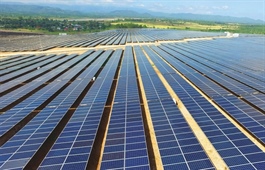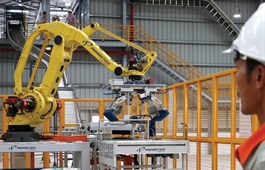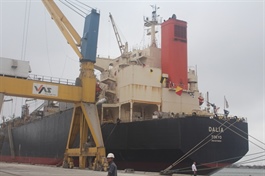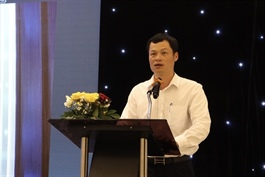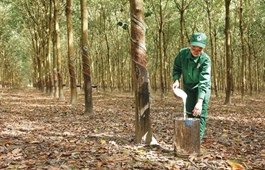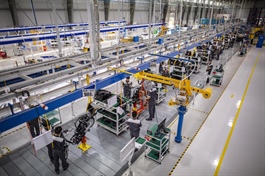Fruit and vegetable exports expected to fall short of yearly target
Fruit and vegetable exports expected to fall short of yearly target
The sector also remains heavily reliant on a handful of key markets, particularly China and the US, leaving it exposed to regulatory shifts or trade policy changes.
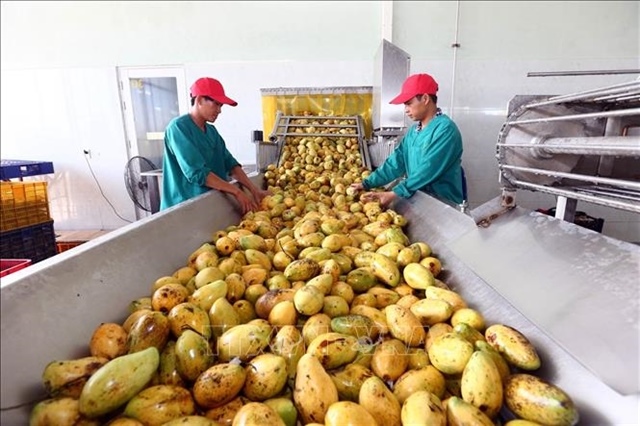
Workers at a mango processing factory in Tây Ninh Province. — VNA/VNS Photo |
Việt Nam's fruit and vegetable exports are expected to fall short of the full-year goal of US$8 billion, despite a strong recovery in the first half of 2025. Seasonal gluts, limited processing infrastructure and inconsistent compliance with international quality standards continue to constrain long-term growth.
According to the Ministry of Agriculture and Rural Development, export turnover in June was estimated at $750 million, marking a surge of more than 50 per cent from the previous month. This brought total fruit and vegetable exports in the first six months of the year to $3.05 billion, a promising rebound after a difficult period.
Yet as harvests peak and fruit floods the market, supply chains often struggle to keep up. This leads to price pressure, post-harvest losses and bottlenecks in distribution. The sector also remains heavily reliant on a handful of key markets, particularly China and the US, leaving it exposed to regulatory shifts or trade policy changes.
Deputy Director of the Department of Crop Production and Plant Protection Nguyễn Quang Hiếu reported that by the end of June, Vietnamese exporters had shipped around 45,000 tonnes of lychee, a 60 per cent increase year-on-year. China recently approved additional planting area and packing facility codes for durian and is expected to send experts to Việt Nam in July to inspect pomelo orchards, moving toward a formal export protocol.
Access to high-end markets, however, depends on strict and consistent compliance with food safety standards. Authorities have urged localities and exporters to adopt clean production models, improve residue testing and enhance traceability systems prior to export clearance.
Post-harvest limitations remain a hurdle. Ameii Việt Nam CEO Ngô Thị Thu Hồng said her company was operating at full capacity to meet demand for premium lychee. However, the lack of irradiation facilities in northern Việt Nam meant that products bound for the US must be transported south for treatment, significantly increasing costs and complicating preservation.
She noted that Vietnamese lychee was often directly compared with products from China and Mexico. To remain competitive, Hồng urged the Government to establish an irradiation centre in Hà Nội and accelerate market access negotiations with Japan and South Korea to diversify export channels.
CEO of Vina T&T Group Nguyễn Đình Tùng reported securing advance orders to the US nearly a month before harvest, crediting brand reputation and reliability. Yet he acknowledged that Vietnamese fruit still lacked international brand recognition. He pointed out that countries such as New Zealand, the US and South Korea had strongly associated fruit identities, while Việt Nam’s premium produce remained underbranded globally.
Japan, however, is emerging as a promising market. According to Tạ Đức Minh, Việt Nam’s Trade Counsellor in Japan, Vietnamese fruits such as lychee, mango, dragon fruit and longan are becoming increasingly popular with Japanese consumers. One Vietnamese exporter shipped more than 100 tonnes of lychee early in the season and expects to reach 200 tonnes by the end.
Major retailers like AEON and upscale supermarkets are actively importing Vietnamese fruit. Notably, lychee is also reaching customers through e-commerce platforms, social media and Amazon Japan.
To strengthen market share in Japan, Minh advised against competing on low prices. Instead, he suggested focusing on value-added strategies such as dried fruit processing, which can fetch two to three times the price of fresh goods, and investing in eco-friendly packaging, a key preference for 60 per cent of Japanese consumers. Transparent traceability, he added, could increase final retail prices by 10 to 15 per cent.
In China, Việt Nam’s Beijing trade office has urged exporters to tighten on-farm quality control, particularly for fresh produce. Where feasible, companies are encouraged to shift to sea and rail transport for greater volume and reliability, rather than relying solely on overland routes.
To reduce congestion during peak harvests, the Fruit and Vegetable Association has recommended coordinated efforts between customs agencies and border authorities to prioritise perishable, high-turnover fruit.
In the long run, the sector must invest in high-quality cultivation zones, implement certified production standards such as VietGAP and GlobalGAP, and ensure full transparency in origin tracking.
Building stronger capabilities in pesticide and heavy metal residue control while scaling up deep-processing technologies will not only diversify export offerings and add value, but also reduce reliance on fresh fruit sales, prolong freshness and enable entry into geographically distant markets with strict quality standards. These measures are essential to support long-term market resilience and position Vietnamese fruit more competitively on the global stage.
- 08:49 16/07/2025





